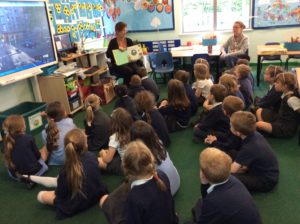What is collective worship?
In church schools, collective worship is seen as more than a daily ‘awe and wonder’ moment. It is the unique heartbeat of the school and is offered as part of a wider opportunity for pupils and adults to encounter and engage themselves in conversation about their beliefs, their values and how we respect the views of all.
Although a Church of England school, it is important to note that worship is truly welcoming, inclusive and represents the principles of Christian hospitality. At St Oswald’s, we have developed an approach that seeks to meet the needs of all faiths and beliefs.
At St Oswald’s, our collective worship is:
 |  |  |  |  |
| Rooted in the school’s vision | Invitational for all to engage in an act of worship | Inspiring, creative and impactful of the whole community | Inclusive to ensure all have a voice and are listed to | Valuable as part of the ethos of the school |
Is collective worship inclusive?
Although rooted in Christian values, our collective worships incorporates all views and opinions. Christianity is not taught within collective worship but is more a reflection on important messages, morals and values that allow children to develop their spiritual and holistic development.
How is collective worship organised?
Throughout the week, children engage in a daily Collective Worship. These include:
- Whole school collective worships
- Phase or Key Stage collective worships
- Class collective worships
These collective worships contain elements of our school values, celebrations and singing.
What is the structure of collective worship?
Collective worship takes the form of 4 parts at St Oswald’s which allow us to create a sacred space and holy moments.

Gathering
A welcoming atmosphere is created within every collective worship throughout the week. As collective worship starts, children expect:
- A welcoming, calming piece of music
- A lit candle
- A collective worship table with coloured cloth according to the church calendar
- A collection of class figures based on those attending
- A familiar, consistent greeting to signal the start of worship
Each class at St Oswald’s is named after an animal (e.g. Ladybirds class or Foxes class). Each class has a small wooden figure which gather under a model of a tree at the start of any collective worship they are part of. This represents all or part of the school community gathering together.
Engaging
At St Oswald’s, we aim for our worships to engage with a variety of stories and teaching of the Christian religion and those with moral messages. To engage children, we aim to:
- Have clearly planned out messages and themes throughout each collective worship
- Share religious stories or moral stories through carefully chosen materials
- Use drama, discussion and fun activities to support in the developing of the worship
- Use ‘I wonder’ questions to encourage reflection
Responding

Our own views, beliefs and opinions are encouraged at St Oswald’s. We provide opportunities to reflect on thoughts, respond to questions and share what each individual is thinking. To do this, children expect:
- Include moments of reflection
- Ask significant questions and take time to share responses from children
- Take a moment of reflection individually, allowing children to incorporate making links to real life. These are often incorporated through moments of stillness.
- Use our school prayer or message specific prayer to develop time for deep thought.
Sending
All collective worships are completed through a consistent, similar sending. Children expect collective worship to end with:
- A completion of the school prayer
- A closing sentence and response (May peace be with you)
- A quiet, reflective song as exiting the hall
- The extinguishing of the worship candle

